This article was written by B. d’Aligny and reviewed by G. Morlat.
See the other articles we made on this theme !
Quantum sensing is the field which consists in measuring physical quantities using quantum phenomena. It is already in use in several areas such as non-invasive medical imagery for its outstanding precision. But quantum sensing is also bringing new kinds of applications, such as locating oneself on the Earth without the need of satellites, as well as monitoring volcanic activities below our feet.
These technologies work by exploiting the high sensitivity of quantum objects to their environment. For example, the presence of a car behind a wall will distort the trajectories of an atom. Measuring one atom’s trajectories can therefore tell us if there is (or not) a car behind the wall. In a totally different approach, particles have a property called “spin”, which can be understood as a tiny magnet. This spin moves differently depending on the surrounding magnetic field and can be used to observe brain activity through the skull.
These two examples show you that quantum sensing is a very diverse field. In the following we introduce several quantum sensing technologies, and a few of its use cases. These examples will give you an overview of the key principles of quantum sensing. Curious readers can then read more by clicking on our suggestions at the end of the article.
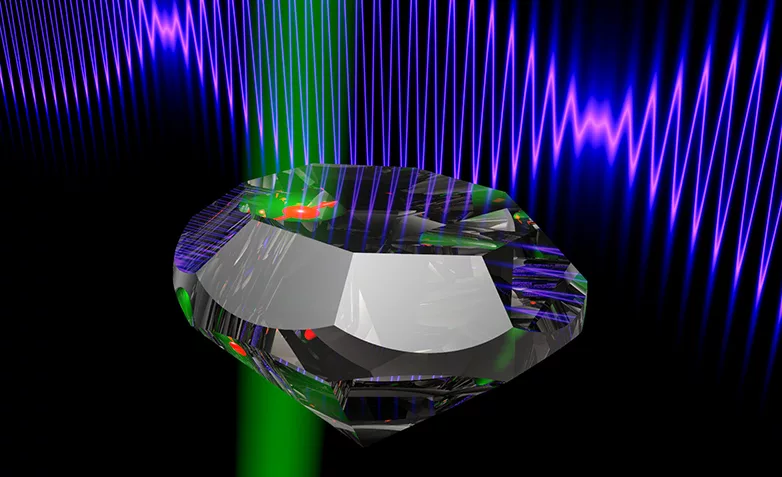
Medical imagery : Optically pumped magnetometers
Quantum sensing presents unparalleled results when it comes to medical imagery. It is particularly the case of magnetoencephalography, which is the mapping of the brain using its magnetic activity. These brain mappings are precious tools for detecting brain diseases such as dementia, Alzheimer’s or Parkinson’s. They can be obtained with particularly high details by using quantum sensors known as “Optically pumped magnetometers”.
In this technology, the quantum object used as a measurement probe is the spin orientation of atoms. The atoms are trapped in a glass box called a “cell”, and are illuminated by a laser: they are “pumped” by the laser. The atoms will absorb a different amount of light depending on the atoms’ spin orientation. In the presence of a magnetic field, the atoms’ spin orientation is changed, thus changing how much the cell absorbs light. We can therefore deduce the magnetic field’s intensity from how much light comes out of the cell.
Because our brain activity emits small magnetic fields, we can map it by measuring the magnetic field around our skull. This mapping is called magnetoencephalography. It is currently mainly achieved using MRIs (IRM in French), which is also built on quantum physics phenomena. But “Optically Pumped Magnetometers” are promising as they are more compact and more precise. This is particularly the case because unlike traditional methods, they do not require voluminous cooling equipment, and the detectors can be put in direct contact with the skull.
This technology shows us a first key component of quantum sensing: it relies on measuring the behaviour of qubits which interact with their environment. However, as you will see in the following paragraphs, “Optically Pumped Magnetometers” are particular among quantum sensing techniques. They do not rely on a single qubit, but rather a crowd of qubits. Indeed, in each cell there are several atoms, which each correspond to one qubit.

Illustration of an OPM. The cell traps a vapour of atoms. source: Tierney, Tim M., et al. “Optically pumped magnetometers: From quantum origins to multi-channel magnetoencephalography.”

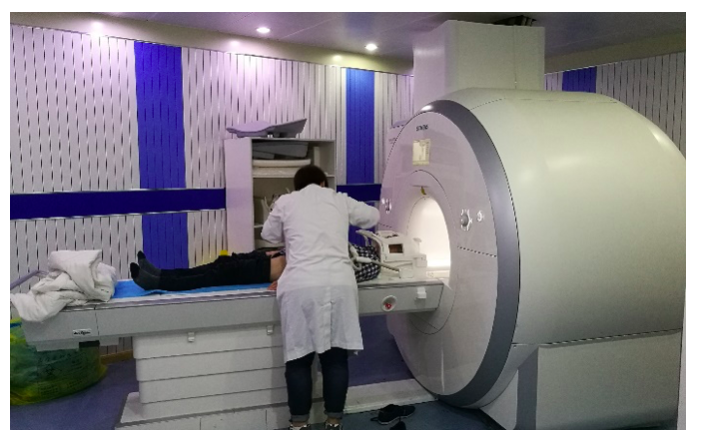
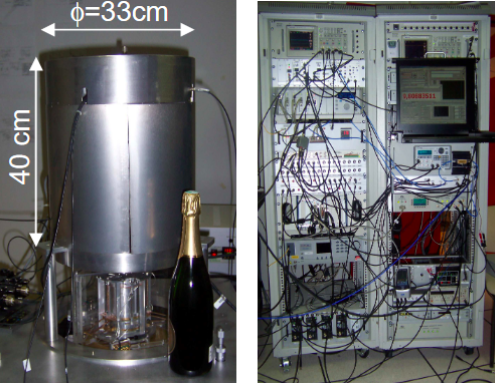
ONERA’s Girafe1 gravimeter (2009). Used for gravity mapping on boats and planes
In this device, the atoms fall over 6cm.
source: Presentation « Gravimétrie absolue marinetrie absolue marine à l’aide d’atomes froids : GIRAFE 2 », 16 novembre 2016, ENSTA-Brest, Colloque CNFG2.
Quantum gravimeters
Quantum sensing is also very promising for measuring gravity. In particular, gravimeters based on cold atoms detect tiny fluctuations of gravity, which can notably reveal to us the underground structure of the Earth. This can be useful for monitoring volcanic activity, as magma displacement generates a change in the gravitational field. It can also be used for mapping the gravity strength around the globe. These gravity maps can then be used for locating oneself without the need of satellite (like the GPS). It is important to notice that these use cases were not doable with previous gravitometers, because they were not sensitive enough.
Gravimetry using cold atoms
The general method for this technology, called “cold atom interferometry” consists in dropping an atom, and making its possible trajectories interfere during the downfall. The atom is put in a superposition of two states, which correspond to two different directions of propagation. In this method, interference of the atom’s trajectories – a direct consequence of quantum superposition – is exploited to increase the precision of the measurement. The steps of the measurements are the following:
Initialize: We use lasers to precisely localize the atom, and cool the system down. We then apply a first laser pulse to the atom, which puts it in a superposition of two different initial speeds. These speeds correspond to the two states of the qubit.
Dropping atoms: The atom will fall in a superposition of two paths. At half the falling time, we apply another laser pulse, which inverts the qubit states. That way, at the end of the falling time, both “paths” will have joined again. However, both paths will have been slightly distorted by the gravitational pull on the atom.
Measurement and interpretation: At the end of the dropping, we send a last laser pulse, which will read the interference of the two paths of the atom. Distortions of the two atom’s trajectories can now be determined from the interference pattern. From there we can deduce a highly precise value of gravity.
Usually, several atoms are dropped together for more precision. Also, the process can be redone regularly in order to obtain the evolution of gravity through time, for example for measuring underground lava movement. If the gravimeter is moving on a boat or a plane for example, repeating the protocol allows us to build gravity maps.
This second approach to quantum sensing shows us that superposition is a useful phenomenon for increasing the precision of measurements. In fact, this method is now so precise that some armies are trying to use it to detect submarines!
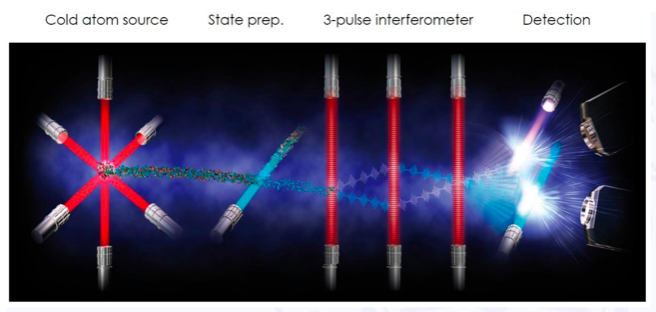
NV centers for all kinds of sensing
NV centers in diamond (abbreviation for Nitrogen-Vacancy centers) are one of the most promising hardware setups in quantum sensing. NV centers are particular defects of diamond which interact strongly with light. By measuring these defects’ spin, we can measure very precisely a large variety of properties, such as magnetometry, and temperature measurement.
NV centers have several interesting advantages compared to other quantum sensing platforms. First of all, it is possible to isolate a single NV center – which has the size of 2 atoms – thus allowing us to obtain unbeatable spatial resolutions. This is a potential gamechanger in biology, as we can now measure temperatures inside living cells. Another advantage of NV centers is its solid diamond structure, which allows it to measure phenomena under high-pressures, while other sensors would be crushed. NV centers can also be used for magnetoencephalography without requiring cumbersome cooling systems.
NV centers are expected to become a cornerstone of quantum sensing, and the few examples we introduced are just the tip of the iceberg.
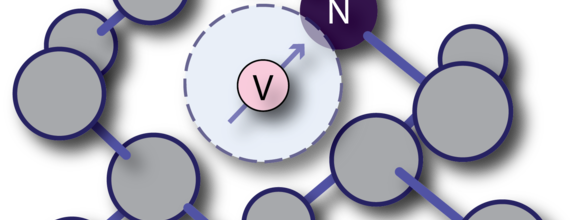
Entanglement-enhanced quantum sensing
The previously presented methods exploit the superposition phenomenon in order to improve measurement precision. But they do not take advantage of the entanglement phenomenon, yet it could strongly improve the precision of quantum sensing. This has already been proven in laboratories, but practical difficulties currently make it difficult to and use it in real-life situations. In fact, entangling quantum objects is one of the most difficult operations in quantum technologies, because of the limitations of decoherence. The two main approaches to entanglement-enhanced quantum sensing are “Distributed quantum sensing”, and the “storage and retrieval” method.
“Distributed quantum sensing” consists in entangling a set of qubits, and then measure a given quantity with each qubit. In certain cases, the entanglement will reduce unwanted measurement perturbations.
In the ““storage and retrieval” method, a highly sensitive “probe” qubit, and a very stable “auxiliary” qubit work together. At the start of the measurement, they are entangled. Then, the “probe” interacts with the physical quantity we want to measure, while the “auxiliary” is protected from its environment to avoid any unwanted perturbation. The “information” about the physical quantity is thus stored in the probe’s state. We then swap the states of the entangled qubits (it would have not been possible without the entanglement). Finally, we can measure the state of the “auxiliary” qubit, which is less sensitive to unwanted perturbations. This method has already provided better-than-classical measurement result, in an experiment which used two photon qubits to measure a distance (you can read more about it here).
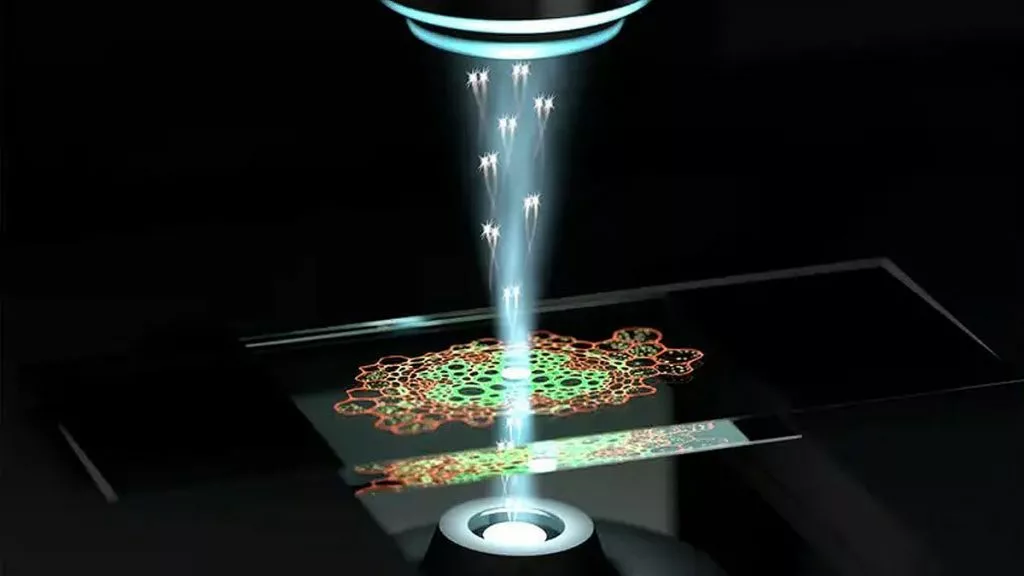
Conclusion
As a conclusion, quantum sensing exists in many forms, and promises to impact a large variety of areas, from medicine to biology and natural risk assessment. The single idea uniting quantum technologies is that they exploit quantum properties of light and matter for measuring stuff with high precisions. In particular, superposition and entanglement are very useful to increase the precision of sensing, yet the latter is still very difficult to master at a commercial scale.
Our suggestions for curious readers
- “Quantum sensing: Poised to realize immense potential in many sectors”, June 10, 2024 – by Henning Soller
- Degen, C. L., Reinhard, F., & Cappellaro, P. Quantum sensing.
- Carioqa project – Quantum gravimeter in satellites
- Stray, Ben, et al. “Quantum sensing for gravity cartography.” (2022)
- Kucsko, Georg, et al. “Nanometre-scale thermometry in a living cell.” (2013)
- Zhuang, Q., Zhang, Z., & Shapiro, J. H. Distributed quantum sensing using continuous-variable multipartite entanglement.
- Rondin, Loïc, et al. “Magnetometry with nitrogen-vacancy defects in diamond.”
- Assouly, Réouven, et al. “Quantum advantage in microwave quantum radar.” (2023)
